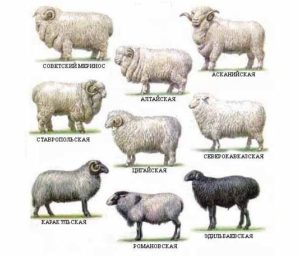 The ancient ancestors of the famous fine-wooled Merino sheep lived in Asia. The Spaniards were the first to domesticate and use their wool. For a long time they tried to strictly keep the secret of the “golden fleece”, and until the 18th century they succeeded. But one day the British accidentally took out several sheep on a ship, and so began their journey around the world.
The ancient ancestors of the famous fine-wooled Merino sheep lived in Asia. The Spaniards were the first to domesticate and use their wool. For a long time they tried to strictly keep the secret of the “golden fleece”, and until the 18th century they succeeded. But one day the British accidentally took out several sheep on a ship, and so began their journey around the world.
Later, other Mediterranean countries, and then America, Australia and New Zealand, became the habitat of merino sheep. Today, the largest population of this breed of sheep is raised in Australia. This country is the main supplier of wool from this animal in the world.
Appearance of Merino sheep
 This animal sometimes looks very unusual and funny, bearing little resemblance to the usual sheep. The entire body of the Merino is covered with thick, long wool with folds. Sometimes it is even difficult to see the sheep's face. The snow-white coat becomes even longer with age (up to 9 cm). Based on their appearance, Merinos can be divided into 3 main categories: fine, medium and strong.The first ones do not have the usual folds on the body, but they have excellent wool, the second ones are larger with 2-3 folds, but the quality of their fleece is worse, and the third ones are the most massive sheep of the breed.
This animal sometimes looks very unusual and funny, bearing little resemblance to the usual sheep. The entire body of the Merino is covered with thick, long wool with folds. Sometimes it is even difficult to see the sheep's face. The snow-white coat becomes even longer with age (up to 9 cm). Based on their appearance, Merinos can be divided into 3 main categories: fine, medium and strong.The first ones do not have the usual folds on the body, but they have excellent wool, the second ones are larger with 2-3 folds, but the quality of their fleece is worse, and the third ones are the most massive sheep of the breed.
Keeping and breeding Merino sheep
Today, merino sheep are grown on almost every continent. Animals are unpretentious to food, easy to care for and reproduce easily. Sheep are able to gnaw the grass in areas where horses and cows grazed before them.
They have good endurance: They can go without water for a long time during long hauls. Animals easily adapt to climate change. But not all areas are suitable for cultivation: sheep do not tolerate the warm and very humid climate of the tropics. This herd animal is very timid, afraid of sharp loud sounds, darkness and confined spaces. Breeding merino sheep is a very profitable business.
Maintenance and care
 Sheep are usually kept in herds. Males are heavier than females and produce more wool. In warm weather, animals feed on fresh grass when grazing. In the cold season, their food is hay, oats, barley, bran, mixed feed and vegetables. It is advisable to additionally add vitamin and mineral complexes to the diet.
Sheep are usually kept in herds. Males are heavier than females and produce more wool. In warm weather, animals feed on fresh grass when grazing. In the cold season, their food is hay, oats, barley, bran, mixed feed and vegetables. It is advisable to additionally add vitamin and mineral complexes to the diet.
In farm conditions, merino sheep live about 6–7 years; in the mountains of Australia, their life expectancy sometimes reaches 14 years. The meat productivity of the breed is insignificant, so they are often raised only for their high-quality fleece. Animals are shorn once a year, in the spring. What other features of animal care are useful to know about for those who decide to raise merino sheep?
A dry and warm room about 2 meters high in winter is suitable as a shed for sheep. One animal requires at least 1.5-2 square meters. m area. In summer it should not be stuffy and cool.The optimal temperature is 5 degrees Celsius, for warm houses - 12 degrees. The room should be ventilated, but without drafts and have a vestibule.
Close to the barn it is necessary to build a pen, twice as large in area. Rectangular troughs are suitable for drinking bowls and feeders. It should be taken into account that a sheep drinks 5–10 liters of water per day.
Breeding
In the barn, rams and sheep live separately. Artificial insemination is often used to improve the breed. Optimally suitable animals are selected for mating in order to obtain healthy and productive offspring. Females begin to give birth to cubs after they are 1.5 years old. Childbirth is usually easy. On average, there are 2-3 lambs in a litter, which can move independently after 30 minutes.
The most famous merino breeds
 One of the very first Merinos was bred by the French. Rambouillet breed. The animal has a strong build and produces up to 5 kg of long, high-quality wool. Has world value Australian merino, obtained by mixing French and American breeds.
One of the very first Merinos was bred by the French. Rambouillet breed. The animal has a strong build and produces up to 5 kg of long, high-quality wool. Has world value Australian merino, obtained by mixing French and American breeds.
European varieties such as electoral, infantado, negretti later they did not become widespread due to poor viability and low wool productivity. (1-4 kg per year).
Sheep Mazaevskaya breed were bred by Russian breeders and became widespread in the North Caucasus. They produce a very large amount (6–15 kg) of fine wool per year. However, the survival rate of this species has worsened due to an incorrect approach to breeding.
New Caucasian breed - the result of crossing the Mazaevskaya sheep and Ramboulier. It is quite common in Western Europe. The animals are strong and produce 6–9 kg of fleece per year.
Soviet merino arose due to the mixing of Ramboulier and New Caucasian breeds. This species is very powerful, with a proportionally developed physique. The horns are small, sharp and curved. There is a fold on the neck. The average weight is 100-125 kg, which is the highest for merino sheep. This species is bred in many regions of Russia for wool and meat.
Also famous in Russia Romanov breed, it is represented by meat and dairy types of sheep that produce a good amount of wool.
Useful properties and value of merino wool
 In the Middle Ages, only very noble people could wear clothes made from expensive merino yarn. What is the value of this material? The uniqueness of Merino sheep wool is its unusually fine fiber (5 times thinner than human hair). It has many valuable qualities, thanks to which it has become widely used throughout the world.
In the Middle Ages, only very noble people could wear clothes made from expensive merino yarn. What is the value of this material? The uniqueness of Merino sheep wool is its unusually fine fiber (5 times thinner than human hair). It has many valuable qualities, thanks to which it has become widely used throughout the world.
Advantages of merino wool (yarn):
- retains heat well;
- protects against moisture;
- does not absorb the smell of sweat;
- has a healing effect;
- wear-resistant;
- light;
- soft;
- elastic;
- durable;
- warm to the touch;
- has a calming effect;
- allows air to pass through well;
- has a wide range of colors;
- environmentally friendly.
Merino yarn is suitable for knitting openwork and voluminous products. Clothes made from it are not cold in the cold, and not hot in the summer. Despite its high cost and many competing modern materials, it has been and remains popular with buyers from around the world.


 0
0





